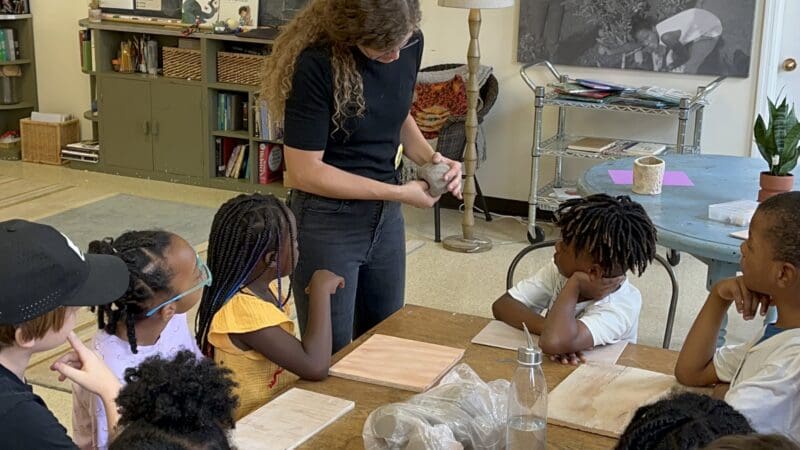Young learners overflow with questions in early education, challenging educators to balance their curiosity alongside curriculum standards and routines. How can educators leverage the enthusiasm of these learners’ inquiries to teach essential skills and content?
This blog post will explore how four elementary teachers integrated the Question Formulation Technique (QFT) in the Use Your Noodle summer program in Birmingham, Alabama where research on the QFT’s benefits for early learners’ skills was conducted. This research has recently been published in a scholarly journal, and the full study can be accessed here. Excited by the QFT, the teachers took it into their own classrooms during the school year. The teachers are Sarah Leffel, a third-grade teacher; Dalia Ramos, a pre-K teacher; Tanishia Smith, a first-grade teacher; and Kristin Williams, a third-grade teacher. Read on to learn of the classroom lessons, challenges and adaptations, and the impact that questioning has had on their students.
Integrating the QFT into Daily Lessons
Teachers found many ways to use the QFT. All four teachers found the QFT applicable to various learning experiences, so QFocus prompts included everything from moon phases to ramps and pathways to music.
Igniting Curiosity through Interactive Exploration
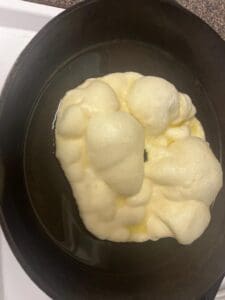 Hands-on activities are fun and effective ways of using the QFT with early learners. Ramos collaborated with a student teacher, Jerica Bell, to tie questioning and food together during the summer program. Using the ingredients for Native American fry bread — excerpted from a book they were reading — as the question focus, students asked questions including:
Hands-on activities are fun and effective ways of using the QFT with early learners. Ramos collaborated with a student teacher, Jerica Bell, to tie questioning and food together during the summer program. Using the ingredients for Native American fry bread — excerpted from a book they were reading — as the question focus, students asked questions including:
- Why does it look like popcorn?
- Es un pastel? (Is it a cake?)
- Why does it look like one of the wall things that bubble up?
- Are we making a cookie?
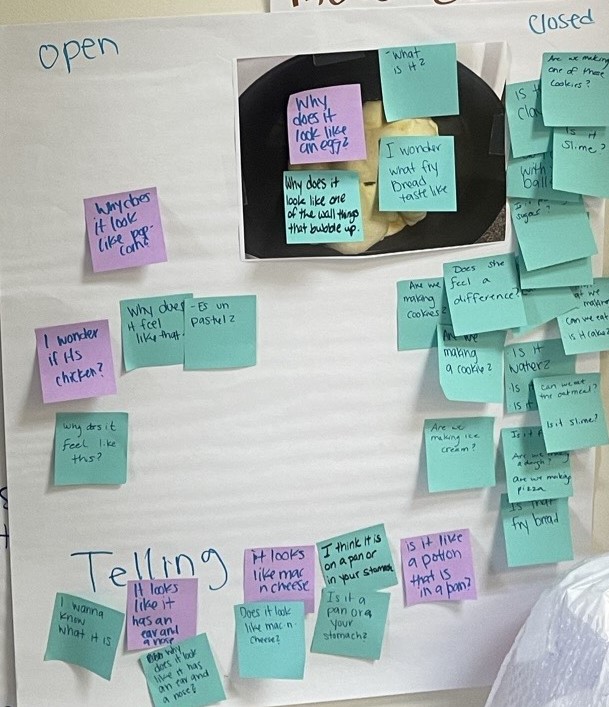
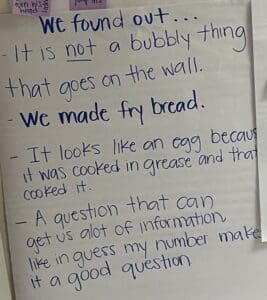
More students wondered if the ingredients would be used to make slime, and while that was not the case, once they made the connection between the ingredients and the book, they exclaimed, “Ooh it’s fried bread! We’re going to make fried bread!” Their investment in making the fried bread (and enjoying eating it) led them to carry the lesson with them to other places — wanting to bring the recipe home and pretending to make fried bread in the dramatic play center the next day.
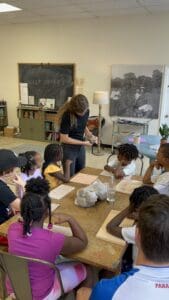
In a similar hands-on fashion, Leffel’s students participated in a QFT session using clay. She invited one of her good friends, a ceramicist, to visit the class. The clay, itself, was the QFocus. Students looked at a completed, fired piece of ceramic that Leffel’s friend had made, and they eagerly played with the wet, raw clay that had been given to them. Questions arose, and students “answered” the questions by making their own ceramic pieces that got fired in a kiln. One of the beautiful things about the QFT is that “it makes you think through all of what you’re seeing and all of the details,” Leffel said of the experience.
Transitioning to Using the QFT in Classrooms
When bringing the QFT from the summer program into their academic year classrooms for the first time, the teachers found that weaving the QFT into contexts where questioning flows naturally helped to make the transition.
Smith’s first-grade class used the QFT as part of their shared reading routine. Incorporating the QFT into their practice of introducing the book on day one, Smith’s first-grade students asked questions based on the book’s cover. She shared that this allowed them to go beyond focusing solely on reading the words correctly to finding meaning in the book.
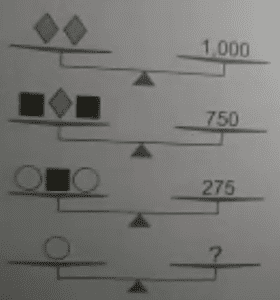
Another way teachers found to integrate questioning into their classroom seamlessly was to leverage a lesson that students found challenging. Williams used the QFT to support her third-grade students struggling with balanced math equations. She observed that with the QFT, students sought understanding rather than feeling defeated.
Lessons Learned: Challenges and Adaptations Specific to Early Learners
Teachers found that understanding the challenges and adaptations specific to early learners is crucial for such lessons to be effective.
1) Challenge: As Leffel and Williams shared, the idea of doing a QFT each day was overwhelming. However, during the summer program, they had the flexibility to do one over the span of a couple of weeks. For early learners especially, hitting all the steps of a QFT in one day can be challenging.
Solution: A solution is to focus on one step a day; work on closed-ended vs. open-ended questions on one day and do prioritization the next. Read about how another early educator does the daily breakdown here.
2) Challenge: “Change statements into questions” is a critical rule for early learners. Many students are unaware when they are stating an idea or a wonder and when they are asking a question. Ramos noted, “Students will say ‘I am asking you a question’ when you ask them to try restating. They’re just not using question words.”
Solution: Ramos continuously reinforces the difference between statements and questions. She makes a point to publicly “catch” a student asking a question when it happens organically. “They ask a million questions daily, so I’m catching that and noticing it aloud: ‘Oh, did you hear that he just asked a question?’ We’re working on them developing the questioning schema.”
3) Challenge: With early childhood students, “you have to change your language just a little bit because they still might not developmentally understand what a question is,” Williams observed. Because students are still developing their awareness of questions, teachers found that a slight wording change — from “question” to “wonder” — often evoked more questions at the start of the QFT.
Solution: “What are you curious about?” or “What are you wondering?” was language early learners could understand to get them to a question, as Williams expressed. Smith noted, “It made it a lot easier for them to turn a statement into a question if you phrased it that way.”
4) Challenge: The open-ended vs. closed-ended question step can be a particular struggle for early learners. Students have trouble recognizing the categories and sometimes can become insistent or upset when they disagree with others about a question’s category.
Solution: Students’ reasoning and the conversation around it became more important than getting closed and open exactly right every time. “What the kids have taught me is — what I think the purpose of the QFT is the conversation that you create around the inquiry, it’s about the inquiry,” Leffel shared. Students can agree to disagree rather than feeling that they must get it “right.”
5) Challenge: Recording questions in small groups can be difficult and time-consuming for children who cannot write independently or who cannot write quickly.
Solution: Teachers often scribe for students, being careful not to judge or change the questions in any way.
6) Challenge: It is difficult to find time for practice and reinforcement.
Solution: Teachers report how important it is to get parents involved by sharing with parents how important questioning is within their classroom and encouraging parents to support students by asking questions and finding answers. After attending the Birmingham Civil Rights Museum with her mother, one of Ramos’ students returned with a wealth of information to share. “She’s 4! But she is telling me all of these things because she is in an environment where her mom allows her to ask questions and gives her the answers,” Ramos shared. Teachers also reported that it was helpful to realize that the QFT did not have to be done from start to finish every single time but could be part of quick moments to voice wonderings. Moments like seeing an unfamiliar bug while walking through a garden or trying foods featured in books allowed teachers to find more informal ways to reinforce the skills.
The Impact of Cultivating Curiosity on Student-Teacher Dynamics
Once students become familiar with the QFT and find a place where questions are encouraged, questioning becomes an organic part of learning. After experiencing the QFT, one of Leffel’s students began to approach her and exclaim, “‘Questions are the best, Ms. Leffel, here are my questions!’” He would then share his questions from the day.
Recognizing the impact questioning has on their students, the teachers became more intentional about making space for these questions. For example, Williams’ Curiosity Wall — a place on the whiteboard for students to leave their questions, modeled after the QFT — helps Williams honor student-generated questions in real-time. Space for student questioning doesn’t only impact student engagement and enthusiasm, but significantly improves their skills in phonemic awareness and oral storytelling as well.
Teachers found that honoring student questions with time and space has an impact beyond the classroom. “That is always my mindset. I am teaching you math, reading, social studies, and science. I also want to instill kindness, goodness, curiosity, fairness, gentleness, and appreciation for beauty and loveliness. So for me, the QFT reminds me that wondering and wonderment are sacred, beautiful, and worthy of time,” Leffel shared. She has also made this space for herself, reminded by the QFT and her students that there’s value in giving yourself room to wonder about the world around you, too.
